The Psychology of Sound: Why Users Love Sound Buttons and How They Enhance Engagement?
Sound is a powerful tool in digital interactions, with the ability to influence human emotions and behaviors in profound ways. From gaming to marketing, sound buttons have become an increasingly popular feature on websites, apps, and digital content. But what makes users so drawn to them? Why is it that a simple click of a button to trigger a sound effect can create such an engaging experience? In this article, we will explore the psychology behind sound buttons, uncovering the reasons why they captivate users, and how creators can harness the power of sound to boost engagement and interaction.
The Emotional Impact of Sound
One of the primary reasons users enjoy interacting with sound buttons is the emotional response that sound triggers. Sound, unlike text or visuals, can evoke strong emotions almost instantly. Whether it’s a familiar sound like the sound of a doorbell or a jingle from a childhood TV show, certain sounds have the power to bring back memories and feelings.

The instant gratification of clicking a sound button
For example, when users hear a cheerful, upbeat sound after completing an action (like adding an item to a cart or completing a task), it can evoke feelings of satisfaction and reward. On the other hand, eerie or suspenseful sounds can create tension or excitement, which is often used in horror games or thrillers. The emotional connection that sound provides is what makes it such an effective tool in keeping users engaged.
The Dopamine Effect: Reward and Reinforcement
The use of sound buttons also ties into the brain’s reward system. When a user clicks a sound button, their brain releases dopamine, the chemical associated with pleasure and reinforcement. This dopamine release encourages users to repeat the behavior, creating a cycle of positive reinforcement. Sound buttons are often used to reward users for completing an action, such as receiving a message, finishing a level, or interacting with a brand.

Sound buttons trigger dopamine release
When users hear a pleasing sound after performing an action, the brain interprets that as a reward, reinforcing the behavior and making them more likely to engage again. This mechanism is particularly useful in gamified experiences, where sound effects signal progress or achievement, driving users to keep playing or interacting to hear more rewarding sounds.
The Power of Familiarity: Recognizable Sounds
Familiar sounds play a significant role in the appeal of sound buttons. Whether it’s a famous movie quote, a meme sound, or a popular song, the familiarity of certain sounds can make the experience more enjoyable. For example, when a user hears a well-known sound like the “Moo!” from a popular viral video or the “Game Over” sound from a classic video game, it triggers recognition and nostalgia.
This sense of familiarity creates an immediate connection, encouraging users to engage more frequently with the content. Nostalgia plays a large part in this, as people are naturally drawn to things that remind them of positive past experiences. By using recognizable sounds in sound buttons, creators can tap into users’ memories and emotions, making their experience more memorable and enjoyable.
Interactive Feedback: Enhancing the User Experience
Sound buttons also provide valuable interactive feedback that enhances the user experience. In interactive applications, websites, and games, users often look for feedback to confirm that their actions have been acknowledged. Sound serves as an immediate and intuitive form of feedback. When a user clicks a button and hears a sound, they instantly know their action has been recognized.
This kind of feedback not only improves the usability of the interface but also increases engagement. For instance, in mobile apps, when a user completes a task or level, the sound effect rewards them and encourages further interaction. The use of sound makes the experience feel more dynamic and responsive, ultimately leading to higher user satisfaction.
Using Sound Buttons for Branding and Personalization
Sound buttons also offer creators the ability to enhance their brand identity and personalize the user experience. By incorporating branded sounds, unique jingles, or signature sound effects, companies can reinforce their brand personality and create a distinct identity for their users. This is why many brands are now incorporating sound effects into their websites and apps.
For example, an e-commerce site might use a cheerful sound to celebrate a successful purchase, while a gaming company might use sound effects to celebrate a player’s victory or achievement. By personalizing the sound experience, brands can make interactions more memorable and meaningful, further strengthening the connection between the user and the brand.
Why Users Keep Clicking: The Fun Factor?
Ultimately, users love sound buttons because they’re fun. The act of triggering a sound, especially one that’s playful, silly, or surprising, adds an element of enjoyment to an otherwise simple interaction. This fun factor is a key reason why sound buttons are widely used in games, social media, and interactive websites. It’s the instant gratification of hearing a fun or amusing sound that drives people to click again and again, keeping them engaged and entertained.
Whether it’s a meme sound, a character quote, or a funny sound effect, users enjoy the playful aspect that sound buttons bring to digital experiences. As such, incorporating sound buttons into your website or app can be an effective way to increase user engagement and create a more enjoyable experience.
Discovering New Sounds at SoundsButtonVIP.com
If you’re looking to add fun, engaging sound effects to your website, game, or app, visit SoundsButtonVIP.com. This platform offers a wide variety of free sound buttons, ranging from movie quotes to meme sounds, that can instantly enhance your digital experiences. With a large collection of curated sound effects, SoundsButtonVIP.com is a great resource for creators looking to add interactive and entertaining audio to their projects.
Conclusion: Embrace the Power of Sound for Better User Engagement
Sound buttons are more than just a fun addition to a website or app—they’re a powerful tool for enhancing user engagement, providing feedback, and creating emotional connections with your audience. By understanding the psychology of sound and incorporating sound buttons strategically, creators can boost interaction and make their content more memorable. Whether you’re using sound for feedback, reward, or fun, sound buttons are a key component of creating a dynamic user experience.
Explore the variety of free sound effects available at SoundsButtonVIP.com and start adding some auditory magic to your next project!

I’m Jabari, and I collect, curate, and share sound buttons for free – just because I love them. SoundsButtonVIP.com is my little gift to anyone who enjoys sound as much as I do.









